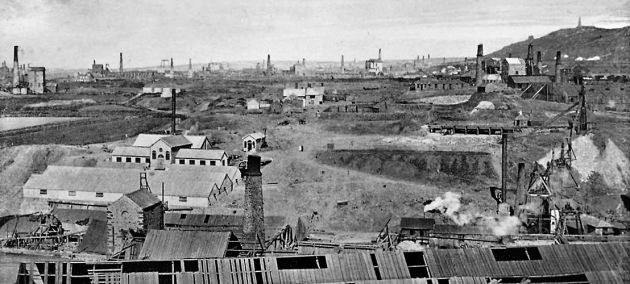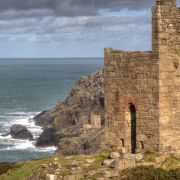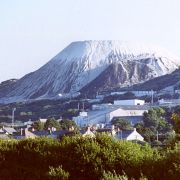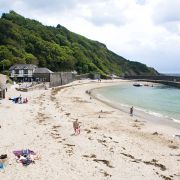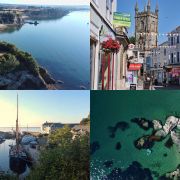Cornish Record Breaking Places
It being a somewhat miserable, rainy day I started thinking about a few "Cornish World records". I have to admit that information is a little scant on some of Cornwall's biggest, oldest and best features so a couple of these might need correction as they were largely based on guesswork / intuition! Most of these facts lie somewhere between interesting statistics and actual record breakers.
Anyway, here is my first attempt to define some natural and man-made record breaking places and structures within Cornwall.
Highest point in Cornwall
Cornwall is a land where you will be lucky to find a stretch of road that is flat for more than half a mile - I know because I ride a bike around here. Despite that the ups are often shortly followed by downs meaning the land here never reaches any great height.
Where the landscape does reach any significant height is Bodmin Moor, and here you will find several peaks that break the 1,000 foot barrier. Of all these the tallest is the slightly comically named Brown Willy. Standing at 1,378 feet (420 meters) above sea level the name originates from the Cornish "Bronn Wennili", which translates to a much more attractive "Hill of the swallows".
Warmest place in Cornwall
Set on the south coast, a few miles west of Penzance is the little, and largely unknown wooded cove of St Loy. Not only is this reputedly the warmest place in Cornwall, but the whole of the UK. This makes it warmer than the both the Scilly Isles and Channel Islands which lie considerably further south.
You will often hear about Cornwall's subtropical microclimate, but please note, this is the average temperature throughout the year. If you come to Cornwall expecting Mediterranean weather during the summer you may be very disappointed! To be honest the Cornish summer is often significantly cooler than much of Southern England.
Deepest mine in Cornwall
Dolcoath - the tin and copper mine between Camborne and Redruth was 870 metres deep (that's over half a mile!). This was also the richest mine in Cornwall which is little surprise when you look at the scale of it back in the late 1800s. The next deepest mine was neighbouring South Crofty which with over a 100 miles of tunnels was the last to be mined in Cornwall.
These deep shafts often went down vertically and meant the miners taking a lengthy journey down to the rock face on some kind of rickety lift mechanism. If this wasn't terrifying enough, many of Cornwall's mine went far out under the sea.
Most populous town in Cornwall
You might think it would be a fairly straightforward question, however in Cornwall we seem to have "conurbations" as opposed to large towns. So, what is actually the most populated part of Cornwall is in fact two, or even three towns bundled together - and they would be Camborne, Redruth and Pool. Whilst it is difficult to know where one starts and the other one ends they are still considered separate towns. Together they are home to over 40 thousand people - nearly double the next biggest town. A similar story is true for Falmouth and Penryn, which also get lumped together.
If you were expecting the only city in Cornwall (Truro) to be next it actually isn't even in the top three, although the population has increased by about 15% in the last ten years. Topping the list in fact is the south coast town of St Austell with a population of around 25,000.
Tallest building in Cornwall
Cornwall is not well known for its skyscrapers and buildings rarely reach over four storeys. It is still the case in most Cornish towns that the easiest point of reference is the church tower and this which will stand above all the other buildings. Nowhere is this more true than in Cornwall's one and only city, Turo. Here the late Victorian Gothic Truro Cathedral dominates the city skyline - well, actually it pretty much is the city skyline! The tallest central spire reaches a fairly impressive 250 feet (76 metres) making it among the tallest in Britain.
The tallest structure in Cornwall is the Caradon Hill transmitter mast which has broadcast TV signals since 1961. Perched on top of Caradon Hill the mast itself rises 780 feet (238 m) above the moorland.
Most expensive property prices in Cornwall
It is no surprise that the most expensive properties in Cornwall command a waterside location. However, what is slightly surprising is it seems that riverside adds as much of a premium as coastal views, with many of the most expensive homes situated on the Rivers Fal, Helford and Fowey. However, to get the absolute maximum price it appears being riverside and having a sea view is the ultimate combination.
Sitting on the eastern bank of the River Camel, looking over towards Padstow is the exclusive village of Rock. For a long time the area has gone by the moniker of Chelsea-by-the-Sea and this is reflected in the house prices. Dotted among the dunes are a number of multi-million pound properties one of which belongs to celebrity chef Gordon Ramsay and another to comedian Harry Enfield.
Most visited tourist attraction in Cornwall
I didn't really need to look this one up... Coming in at number one as the most popular tourist attraction in Cornwall is the Eden Project, of course. The only surprise here is how much more visitor footfall the place receives compared to Cornwall's other tourist hotspots. The Eden Project gets over a million visitors a year, basically triple the number of the next most popular attraction, the Lost Garden's of Heligan. Whether by coincidence, good marketing or genius, both attractions are the brainchild of Tim Smit. His most recent purchase is the Charlestown Shipwreck & Treasure Centre, so we shall watch developments here with interest.
Third spot on the list goes to St Michael's Mount in Marazion which doesn't trail Heligan by much with around 350 thousand visitors a year.
Biggest surf in Cornwall
Cornwall forms a long peninsula facing directly into thousands of miles of open Atlantic Ocean. This means huge winter swells roll into the Cornish coast virtually uninterrupted, much as they do in Portugal's Nazare, home of the biggest waves ever to be surfed. OK, so maybe we don't quite get 100ft+ waves here - the continental shelf extends a couple of miles off the coast taking some of the sting out of the ground swells. But, come winter, there is no shortage of surf and the challenge is often finding somewhere sheltered enough.
When the planets do align and the wind, tide and swell are all right there only a few spots that can handle waves over head height. One of these is Porthleven on the south coast; this notorious reef break has on occasion been surfed at triple-head height. However, the only true big wave spot in Cornwall has to be the Cribbar. Most of the year this reef off the northern end of Fistral beach goes unnoticed, but once or twice every winter, when the swell tops 10ft, the Cribbar roars into action producing surfable waves of over 30ft.
Highest Cliff in Cornwall
If you were tasked with thinking of a name of the highest coastal cliff in Cornwall you couldn't do much better than High Cliff! Yes, that's the name of this towering section of cliff between Crackington Haven and Boscastle on this extraordinarily rugged section of North Cornish coast.
The actual cliff here rises a precipitous 735 feet (220 metres) from the sea below, that's three times the height of Truro Cathedral. I have to say, as someone who is not a fan of heights, the clifftop here isn't too scary as most of it isn't that sheer. On the other hand, the views are pretty spectacular.
Longest Beach in Cornwall
What seems like an obvious question turns out to be a little more complicated... which is the longest beach in Cornwall? There are a couple of points that make answering a little tricky; firstly many of the longer beaches are arbitrarily divided up. Secondly, and not unrelated, quite a few beaches are massive at low tide when they join up with neighbouring beaches. However, as the tide comes in they return to being smaller coves.
It seems the received wisdom on this question is that Gwithian Towans, part of Hayle's "3 miles of golden sand", is the longest. I know this beach well, but couldn't tell you for sure where it becomes Mexico Towans or Godrevy. There's no arguing it is long though.
Some other suggestions are the low tide stretch of sand in Bude Bay from Duckpool to Summerleaze, or the vast swathe of beach at Whitsand Bay in southeast Cornwall. And let's not forget the enormity of Perranporth Beach which joins up with Penhale Sands at low tide.
Oldest ancient site in Cornwall
What I thought would be a fairly straightforward question has actually proven to be somewhat more difficult to answer than expected. As we know, Cornwall is particularly rich in ancient sites - particularly the Far West and Bodmin Moor. These prehistoric structures generally fall into three categories depending on their age. The most recent are Iron Age which overlaps with the Roman occupation of Britain. Many of these are hill forts and villages such as Chysauster and Bodrifty.
The previous period was the Bronze Age which ran from around 3000 to 1200 BC. This was probably the most prolific period of ancient engineering and the majority of Cornwall's ancient sites date back to around this time.
Stretching back in time towards the Ice Age and beyond is the Stone Age. It is towards the end of this period, on the cusp of the Bronze Age, that some of Cornwall's most iconic structures were built. Around this time some of the most impressive quoits were put up. These were burial chambers for the elite of the day - tribal chieftains and the likes. Which of these is the oldest I couldn't tell you, however I do have a nice photo of Chun Quoit, which is definitely very old!
Weirdest place name in Cornwall
Whilst you might think this one is totally subjective, a quick bit of research bought up some of the very candidates I was thinking of. Heading the list for me is Ventongimps between Truro and Perranporth. The actual place is a little underwhelming, though quite pleasant. However, I have had only limited success in finding out what the name means; the first part ("Venton") means a spring or fountain, but the second part appears to have no translation. Therefore I will make the assertion that Ventongimps translates as the "Fountain of the Gimps"
I do have a few other favourites including Botus Fleming, Towednack, Nancegollan and not to mention Barcelona.


